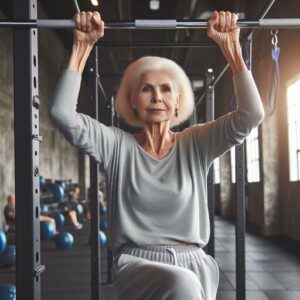
If you’re an elderly woman who’d like to learn to do pull-ups, then go for it!
Elderly age, in and of itself, does not make it harmful for a woman to train at pull-ups or chin-ups.
“There’s no specific contraindication for an elderly woman without shoulder issues to try chin-ups,” says D’Wan Carpenter, DO, a board certified physical medicine and rehabilitation physician with SIMEDHealth in FLA.
“If she has never tried any exercise like this before, it would be best to work her way up to it.
“She will have to understand she will be relying solely on her arms to be able to lift the rest of her body. As long as both upper extremities are injury-free she is safe to try chin-ups.”
Brittle Bones
In fact, if a woman over age 65 has osteoporosis (brittle bone disease), her contraindications are impact exercise like running, jumping and certain forms of other aerobic activity.
Pull-up/chin-up training is a non-impact activity that’s safe on the joints.
Built-In Safety of Pull-ups
And I’ve got news for you: It’s not easy to overdo it with pull-up training. It’s pretty much basically this: You either can or you can’t do it.
It’s not like, say, the bench press, where you can keep straining and straining with endless sets and countless repetitions because you can adjust the weight of the barbell. You can then end up hurting a shoulder joint.
But with chin-ups, once you begin fatiguing, you have no choice but to quit and recharge fully before your next set, since you can’t adjust your body weight like you can adjust a barbell weight.

Depositphotos.com
Though sets can be overdone in terms of volume if a woman uses a gravity-assist machine, I strongly urge against this device, as it’s a poor way to learn to do a chin-up or pull-up. (More on that coming up)
So the issue isn’t the safety of pull-up and chin-up training for an elderly woman. The issue is her fitness level at the time she decides to pursue this goal.
Another issue is her body weight. If she’s overweight, learning chin-ups will be a lot more difficult than if she’s, say, 125 pounds.
Requirements for an Elderly Woman to Learn a Chin-Up
“Elderly” literally means over age 65, though the senior citizen discount at retailers begins at age 55; and age 55 and over is what often applies to senior housing. But you get the point.
A woman over age 55 or 65 who has a base fitness level from long-term strength training, and who’s not overweight, is an excellent candidate to learn chin-ups.
She is more likely to injure her elbows playing golf or tennis, by the way.
Next, she needs a healthy pair of stable shoulders; no rotator cuff issues or painful bursitis.
A requirement is the ability to dead hang from a bar for 20 seconds. This can take a while to build up to.
Once a senior woman is able to dead hang for 20, maybe 30 seconds, she will be that much closer to developing the strength to pull herself halfway up.
Assist Machines
Stay away from these. Though this article is about whether or not chin-up training is safe for the elderly woman, I’m going to briefly explain why assist machines are useless.
They skewer the position that the body naturally hangs in when hanging from a bar without the feet touching anything below.
If you’re doing pull-ups or chin-ups while your feet are connected to a moving platform that subtracts body weight, this will fail to mimic the natural hanging position.
In order to develop sufficient strength to pull yourself up with your feet dangling in the air, you must train with your feet dangling in the air.
So how do you train if you can’t even pull up one inch?
I’ll end up with a 2,000-word post if I explain everything, but suffice it to say that you must develop strength with cable pull-down motions, rowing motions and core-strengthening activities like pushups, kettlebell swings and planks.
And then practice your dead hanging.
At some point you’ll feel ready to attempt a pull. Have a partner place their hands on your waist to help you. You can also practice with tension bands.
Another way to practice is to have a stool at your feet so that you can pull up while your feet are still on the stool to help subtract body weight.
Unlike the assist machine, this subtraction won’t skewer your body’s natural hang position enough to thwart your training.
It is perfectly safe for an elderly woman, under the aforementioned circumstances, to learn how to do chin-ups and pull-ups.
 Dr. Carpenter is one of the nation’s top board-certified physical medicine and rehabilitation physicians, a national speaker, medical legal expert and independent medical examiner. She is founder and Chief Medical Officer of DJC Physical Medicine Consultants. Follow Dr. D’Wan on Twitter.
Dr. Carpenter is one of the nation’s top board-certified physical medicine and rehabilitation physicians, a national speaker, medical legal expert and independent medical examiner. She is founder and Chief Medical Officer of DJC Physical Medicine Consultants. Follow Dr. D’Wan on Twitter.
 Lorra Garrick is a former personal trainer certified through the American Council on Exercise. At Bally Total Fitness she trained women and men of all ages for fat loss, muscle building, fitness and improved health.
Lorra Garrick is a former personal trainer certified through the American Council on Exercise. At Bally Total Fitness she trained women and men of all ages for fat loss, muscle building, fitness and improved health.
.
























